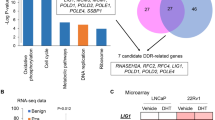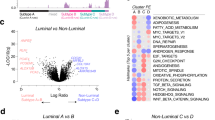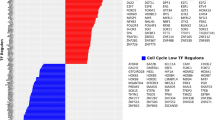Abstract
The molecular mechanisms for hormone-resistant prostate cancer progression still remain elusive, mainly due to the limited availability of corresponding tissue. As transurethral resection (TUR) is a common palliative therapy for patients with hormone refractory prostate cancer (HRPC) who have subvesical obstruction, we aimed to demonstrate that TUR samples can be used to identify significantly affected biological pathways during the switch to HRPC using oligonucleotide microarray analysis. Among the most significantly deregulated pathways in HRPC, we observed an induction of oxidative phosphorylation and a repression of cytoskeletal components.
This is a preview of subscription content, access via your institution
Access options
Subscribe to this journal
Receive 4 print issues and online access
$259.00 per year
only $64.75 per issue
Buy this article
- Purchase on Springer Link
- Instant access to full article PDF
Prices may be subject to local taxes which are calculated during checkout



Similar content being viewed by others
Accession codes
References
Gronberg H . Prostate cancer epidemiology. Lancet 2003; 361: 859–864.
Isaacs JT . The biology of hormone refractory prostate cancer. Why does it develop? Urol Clin North Am 1999; 26: 263–273.
Culig Z, Hobisch A, Cronauer MV, Radmayr C, Trapman J, Hittmair A et al. Androgen receptor activation in prostatic tumor cell lines by insulin-like growth factor-1, keratinocyte growth factor, and epidermal growth factor. Cancer Res 1994; 54: 5474–5478.
Liu Y, Majumder S, McCall W, Sartor CI, Mohler JL, Gregory CW et al. Inhibition of HER-2/neu kinase impairs androgen receptor recruitment to the androgen responsive enhancer. Cancer Res 2005; 65: 3404–3409.
Zhang F, Lee J, Lu S, Pettaway CA, Dong Z . Blockade of transforming growth factor-beta signalling suppresses progression of androgen-independent human prostate cancer in nude mice. Clin Cancer Res 2005; 11: 4512–4520.
Rhodes DR, Yu J, Shanker K, Deshpande N, Varambally R, Ghosh D et al. Large-scale meta-analysis of cancer microarray data identifies common transcriptional profiles of neoplastic transformation and progression. Proc Natl Acad Sci USA 2004; 101: 9309–9314.
Best CJM, Gillespie JW, Yi Y, Chandramouli GV, Perlmutter MA, Gathright Y et al. Molecular alterations in primary prostate cancer after androgen ablation therapy. Clin Cancer Res 2005; 11: 6823–6834.
Holzbeierlein J, Lal P, LaTulippe E, Smith A, Satagopan J, Zhang L et al. Gene expression analysis of human prostate carcinoma during hormonal therapy identifies androgen-responsive genes and mechanisms of therapy resistance. Am J Pathol 2004; 164: 217–227.
Scher HI, Steineck G, Kelly WK . Hormone-refractory (D3) prostate cancer: refining the concept. Urology 1995; 46: 142–148.
Irizarry RA, Bolstad BM, Collin F, Cope LM, Hobbs B, Speed TP . Summaries of Affymetrix GeneChip probe level data. Nucleic Acids Res 2003; 31: e15.
Mansmann U, Meister R . Testing differential gene expression in functional groups. Goeman's global test versus an ANCOVA approach. Methods Inf Med 2005; 44: 449–453.
Van der Laan M, Pollard K . A new algorithm for hybrid hierarchical clustering with visualization and the bootstrap. J Stat Plan Inter 2003; 117: 275–303.
Goeman JJ, Oosting J, Cleton-Jansen AM, Anninga JK, van Houwelingen HC . A global test for groups of genes: testing association with a clinical outcome. Bioinformatics 2004; 201: 93–99.
Benjamini Y, Hochberg Y . Controlling the false discovery rate: a practical and powerful approach to multiple testing. J R Statist Soc B 1995; 57: 289–300.
Yu YP, Landsittel D, Jing L, Nelson J, Ren B, Liu L et al. Gene expression alterations in prostate cancer predicting tumor aggression and preceding development of malignancy. J Clin Oncol 2004; 22: 2790–2799.
Rossignol R, Gilkerson R, Aggeler R, Yamagata K, Remington SJ, Capaldi RA . Energy substrate modulates mitochondrial structure and oxidative capacity in cancer cells. Cancer Res 2004; 64: 985–993.
Choi JK, Yu U, Yoo OJ, Kim S . Differential coexpression analysis using microarray data and its application to human cancer. Bioinformatics 2005; 21: 4348–4355.
Acknowledgements
This research study was supported by a Research Grant of Novartis Oncology. We thank Karen Czeloth for critically reviewing this manuscript.
Author information
Authors and Affiliations
Corresponding author
Rights and permissions
About this article
Cite this article
Stoss, O., Werther, M., Zielinski, D. et al. Transcriptional profiling of transurethral resection samples provides insight into molecular mechanisms of hormone refractory prostate cancer. Prostate Cancer Prostatic Dis 11, 166–172 (2008). https://doi.org/10.1038/sj.pcan.4501001
Received:
Revised:
Accepted:
Published:
Issue Date:
DOI: https://doi.org/10.1038/sj.pcan.4501001
Keywords
This article is cited by
-
The prognostic utility of the transcription factor SRF in docetaxel-resistant prostate cancer: in-vitro discovery and in-vivo validation
BMC Cancer (2017)
-
A spatiotemporal hypothesis for the regulation, role, and targeting of AMPK in prostate cancer
Nature Reviews Urology (2017)
-
Identification of candidate miRNA biomarkers from miRNA regulatory network with application to prostate cancer
Journal of Translational Medicine (2014)
-
Androgens regulate prostate cancer cell growth via an AMPK-PGC-1α-mediated metabolic switch
Oncogene (2014)
-
Genexpressionsprofile bei hormonrefraktären Prostatakarzinomen
Der Urologe (2007)



